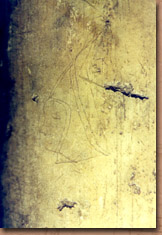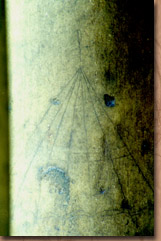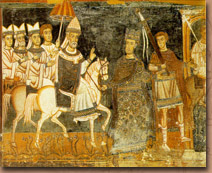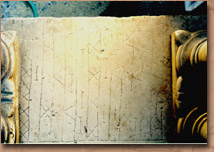Historical engravings in the cloister
edited by Luca Della Santa and Luca Giuggiolini
A visitor's first, highly emotional impact experienced upon viewing a building is gradually replaced by an historical-critical analysis of its surfaces, one which gradually reveals the effects of the ageing process.
Two
columns and a stone slab in the northern side of the Cloister caught our
attention on account of the richness of the information they yielded.
The first column bears an engraved human face whose headdress reminds
one of those cowls or veils worn by nuns or monks (see photo 1).The second
column carries an incision which can be interpreted as an umbraculum
(see picture 2), a cone-shaped, umbrella-like cosmic symbol borrowed from
the Roman empire and used by popes in procession. It is possible to detect
the presence of an oblique handle among other chaotic incisions and scratches.
Some notes concerning the sources of that incision:
1) The frescoes in the Chapel of Saint Sylvester (1247) present a similar
umbraculum (see picture 3);
2) The nuns' convent is situated beside the road used by newly-elected
popes to reach St. John Lateran during their first procession from St.
Peter's. Agostino Paravicini Bagliani (Le chiavi e la tiara. Immagini
e simboli del papato medievale, Rome: Ed. Viella, 1998) supposes that
this ceremony could be the one represented in the intaglio (nowadays in
the Palazzo Pitti) where an acolyte carrying an umbraculum accompanies
the pope who rides on a horse.
The third and most challenging object to identify is the quickly carved slab with fifteen parallel lines alternated with signs which can be interpreted as Roman cardinal numbers (see picture 4). The hypothesis concerning the game which is engraved on the stone is still being researched, although many other possibilities must be considered (notes on a merchant's counter, a meditation board, an abacus). A scholar from the Warburg Institute in London (see Matizia Maroni Lumbroso, Un quiz da risolvere nel chiostro dei Ss. Quattro Coronati, L'Urbe 2 (1963), pp.38-43) believes that the engraving could be a skill and chance game. A player scores the highest number of points by spinning a top or tossing a little ball so that it stops on the columns indicating the highest points, but he also risks that it will stop on the ones with the lowest points, which stand close to the latter.Nevertheless, no hypothesis accounts for the boundary of the game: what happens in case the top or ball overrides the playing area? And why is that 80 points can be scored at one end of the game area, while 100 points can be scored at the other? The following interpretation may account for the discrepancy. A player stands near the short side of the game in order to read the 'V's correctly while two 'barriers' mark the boundary of the game on its short sides. In order to get 80 points the object has to stop on the corresponding column after bouncing off the furthest barrier of the game. In order to score 100 points both 'barriers' have to be used as 'cushions', but the player runs the risk of obtaining only one point in the event that his toss is too strong. It is interesting to notice a certain symmetry in the distribution of scores, probably in order to make the game easy to learn by heart and replicate elsewhere. Something similar to our 'game' can be found in Edward Falkener's Games Ancient and Oriental and How to Play Them (New York: Dover Publications) where he published a drawing from the Basilica Julia made by his friend George Dennis in 1892, although in that case the 'V's were replaced by 'X's, and were limited to eight.
|
© 1999 Coordination
Monica Morbidelli |
|
Fig. 1 - Engraving on a column from the northern side of the cloister.
Fig. 2 - Umbraculum (?) engraved on a column from the western side of the cloister.
Fig. 3 - Fresco in the Chapel of St. Sylvester with an umbrella carried by an acolyte above the pope's head.
Fig. 4 - Engravings on the stone slab from the northern side. |
|
|
|
|
|
|
|
|



